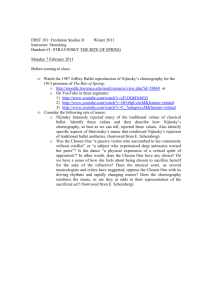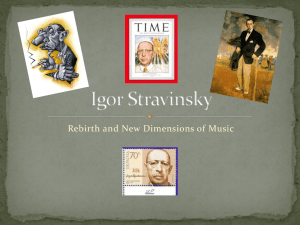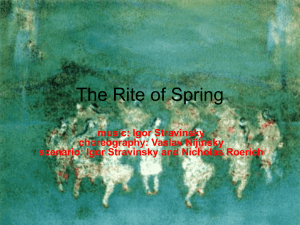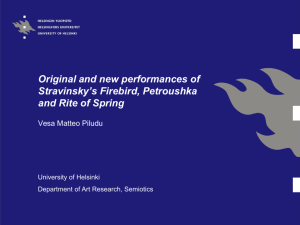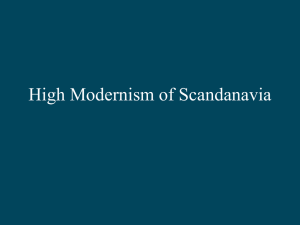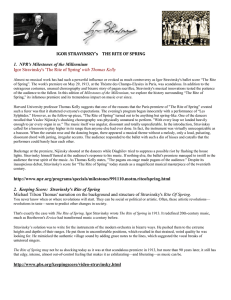Rite of Spring
advertisement
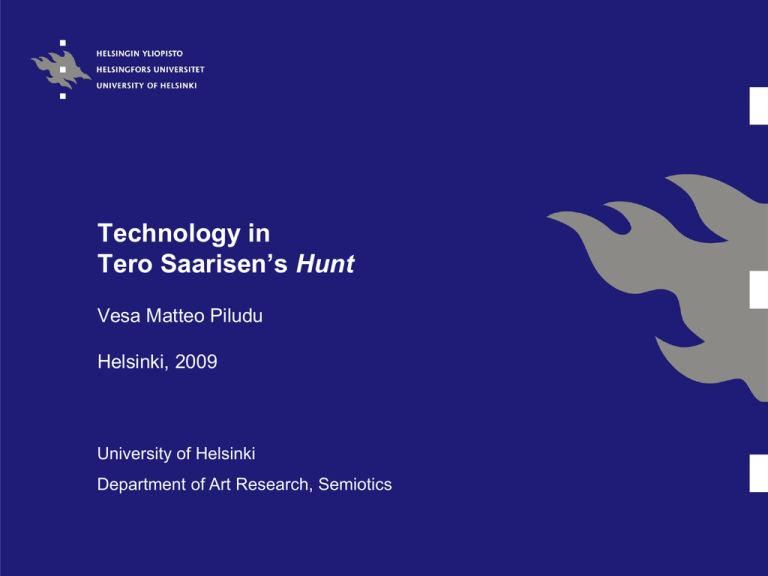
Technology in Tero Saarisen’s Hunt Vesa Matteo Piludu Helsinki, 2009 University of Helsinki Department of Art Research, Semiotics Teero Saarinen’s Hunt Solo dance Choreography: Tero Saarinen Dancer: Tero Saarinen Based on Rite of Spring Music by Igor Stravinski Multimedia: Marita Liulia Light design: Mikki Kuntu Costume design: Premiére: Venice Biennale, 2002 First Saarisen’s solo, still performed today Igor Fyodorovich Stravinsky (1882 –1971) Игорь Фёдорович Стравинский Music scores commissioned by impresario Sergei Diaghilev and performed in the ballets of the dance company Ballets Russes (Russian Ballets) of Paris Le Sacre du Printemps or The Rite of Spring (1913) The ballet was considered innovative and avant-garde, even if they were based on artists’ visionary ideas about Russian ancient paganism It was typical of the period doing avant-garde based on folklore or distant cultures (the so-called primitivism) Juri Lotman’s theory and Stravinsky’s ballets Difference between the symbol (signifier) and the meaning of the symbol (significans) Certain symbols have an enormous capacity of resistance (conservativism or memory of symbols: folklore legends) The same symbol can have different meanings in different cultural contests (cultural relativism, horizontal) If the cultural contest changes, the interpretation and the meaning of the symbol could change (symbolic dynamic, vertical): same signifier, different significants In the case of Stravinsky he used symbols and myths from Russian folklore to produce avant-garde music and ballets: the symbols could be traditional, but their meaning is completely different from the one they had in the rural Russian oral culture Stravinsky’s ballets as modern tradition All the Stravinsky’s ballets are now performed by numerous modern dance companies. What was avant-garde became a kind of modern tradition. Rarely these ballets are performed in the same way as the original ones Often the interpretations contains radical changes and we can talk about new ballets based on the original ballets We can say that the Stravinsky’s ballets are like jazz standards: there is a basic theme, but large improvisations are allowed In contemporary dance, the public isn’t waiting for fidelity, is searching for something new, surprising or even shocking The Rite of Spring, 1913 imaginary ancient Russia It has the subtitle "Pictures from Pagan Russia" (French: Tableaux de la Russie païenne) Colourful idea of violent and cruel pagan Russia: a girl dance herself to death for her community, in order to fulfil a sacrifice to the god of Spring in order to gain his benevolence No reference to recent or living folklore: the Russian peasants’ spring rites didn’t include any sacrifice in the XIX century Reference to a tragic romantic vision of a distant past (XIX century’s and early XX century’s myths) Intensely rhythmic score, sometimes based on some extract of folk music Rite’s vision ”In St. Petersburg … I had a fleeting vision which came to me as complete surprise, my mind at the moment being full of other thing. I saw in imagination a solemn pagan rite: sage elders, seated in a circle, watched a young girl dance herself to death. They where sacrificing her to propitiate the god of spring … I must confess that that vision made a deep impression on me, and as I at once described it to my friend, Nicholas Roerich, he being a painter who had specialized in pagan subjects. He welcomed my inspiration with enthusiasm, and became my collaborator in this creation.” (Stravinsky, An Autobiography, 1990 (1936), Marion Boyard, London, page 31) Nicholas Roerich's 1913 set design for Part I: Adoration of the Earth. Performers at the prémiere of Rite of Spring 29th May of 1913 at the Théâtre des Champs-Élysées of Paris Set design and costumes by archaeologist and painter Nicholas Roerich Original choreography by Vaslav Nijinsky Prémiere’s music conducted by Pierre Monteux Score of Rite Stravinsky used asymmetrical rhythms, dissonance, polyrhythms, polytonality, layering of ostinati (persistently repeated ideas) Opening of the final section, the "Sacrificial Dance“: The scandal of the prémiere The strong rhythm The “primitive” and rude setting The violence of the theme The link dance/sexuality/fertility/death The “unhappy end” Nijinsky's radical departure from classical ballet’s clichés (body components curled inward not opened outward, body pulled down not lifted up, steps heavy not light, focus on grotesqueness not elegance) shocked completely the audience accustomed to the conventions of classical ballet The booing started at the very start of the performance Loud arguments between “denigrators” and “supporters” degenerated in shouts and riots The police was able to restore the order, but not completely The scandal I left the auditorium at the first bars of the prelude, which had at once evoked derisive laughter. I was disgusted. These demonstrations, at first isolated, soon became general, provoking counterdemonstrations and very quickly developing into a terrific uproar. (Stravinsky, An Autobiography, 1990 (1936), Marion Boyard, London, page 47) Different reactions Stravinsky fled from the Theatre, crying Diaghilev affirmed that the scandal was "just what I wanted!" Stravinsky vs. Nijinsky ”I should archive nothing until I taught him the very rudiments of music: values – semibreve, minim, crochet, quaver, etc. – bars, rhythm, tempo and so on. He had the greatest difficulty in remembering all of this.” Nijinsky complicated and encumbered his dances beyond all reason, thus creating difficulties for the dancers that were sometimes impossible to overcome. It was evident that the poor boy had been saddled with a task beyond his capacity. (Stravinsky, An Autobiography, 1990 (1936), Marion Boyard, London, page 41) Stravinski on the choreography What the choreography expressed was a very labored and barren effort rather than a plastic realization flowing simply and naturally from what the music demanded. How far it all was from what I had desired! In composing the Sacre I had imagined the spectacular part of the performance as a series of rhythmic mass movements of the greatest simplicity which would have an instantaneous effect on the audience, with no superfluous details or complications … the only solo was to be the sacrificial dances at the end of the piece. But there again, although he had grasped the dramatic significance of the dance, Nijinsky was incapable of giving intelligible form to its essence, and complicated it either by clumsiness or lack of understanding. (Stravinsky, An Autobiography, 1990 (1936), Marion Boyard, London, page 48) Steps and tempo For is undeniable clumsy to slow down the tempo of the music in order to compose complicated steps which cannot be danced in the tempo prescribed. Many choreographer have that fault … (Stravinsky, An Autobiography, 1990 (1936), Marion Boyard, London, page 36) Rite and butoh the controversial, violent, pagan and primitivist thematic material of the Rite of Spring, greatly influenced Hijikata and Tamano butoh Interesting is the fact that butoh is a kind of modern dance in which isn’t necessary to follow the tempo of the music Tero Saarinen’s Hunt The Hunt is a solo performance of Tero Saarinen based on the Rite of Spring Saarinen is both choreographer and dancer, interpreting the girl that will be dance herself to death The style is an interesting mixture of western contemporary dance and Japanese butoh At the moment of the sacrifice, the multimedia artist Marita Liula project and move photos of Saarinen itself on the body of Saarinen There are two dances at the same time: the one of Saarinen and the movements of the digital photos At the moment of sacrifice, the digital images shown only separated parts of Saarinen face … and finally Saarinen jump high and the lights are turned off Video http://www.terosaarinen.com/en/works/all_creations/ http://www.youtube.com/watch?v=l8eunLu6JgI http://www.youtube.com/watch?v=Q3hcSoIcY4o The critic of techology in Hunt Saarinen wasn’t interested in the colorful folkloric exotism loved by the Ballet Russe He seen the multimedia sacrifice as a metaphor of what happens every day: people are sacrificing their soul and their bodies to serve a technocratic society His protest against technocracy doesn’t include a complete refuse of technology, which could be used in a creative and even liberating artistic way, as in his dance So the problem is how technology is used, and if technology became the only goal, not a way to achieve something else Marita Liulia’s multimedia Technology in Hunt Are we sacrificing ourselves and all our ancestral knowledge, for the flood of new attractive information and invention? Tero Saarinen Social sacrifice: uncritical acceptance of all is “innovation” Physical sacrifice: obesity, asexuality, no contact with own body Cultural sacrifice: loss of contact with (the Finnish) nature and natural mysticism Reaction of the public and critics The public and critics were extremely positive towards the innovations of Saarinen The social critics, as they were expressed in a creative and surprising way, were also well accepted We are in a time in which the followers of ballets are searching for something more than mere executions of classics and the even the radical reinterpretations are more accepted than the most pure philological performances Today, the public is less exited by colorful dresses and exoticism and the primitivism’s artistic attitudes sounds somewhat ridiculous, showing clichés of Russian folklore that are too distant from nowadays realities and imaginary The new interpretations, to be loved and better understood, must include references to the contemporary cultural and social contest Conclusions The paradox of the contemporary Stravinsky’s ballets is that today to be loyal to the Stravinsky’s tradition doesn’t mean to repeat exactly all the movements of the original ballets or use the same instruments, but produce innovations in the interpretation and be loyal to the avant-garde spirit
